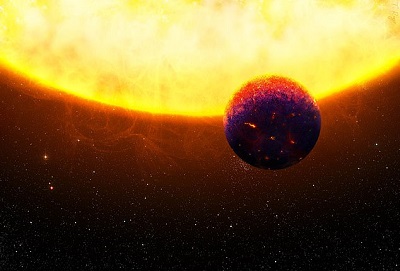The GEMSTONE planet: Researchers reveal ‘shimmering’ super-Earth 21 light years away that could be covered in sapphires and rubies
Researchers have discovered a unique ‘shimmering’ planet they say could be a new class of exoplanet.
Officially known as HD219134 b. it is 21 light years away from us in the constellation Cassiopeia, according to Daily Mail.
Astronomers say unlike Earth, it most likely does not have a massive core of iron, but is rich in calcium and aluminium which makes it incredibly rich in gemstones
‘Perhaps it shimmers red to blue like rubies and sapphires, because these gemstones are aluminium oxides which are common on the exoplanet,’ says Caroline Dorn, astrophysicist at the Institute for Computational Science of the University of Zurich who led the new study.
With a mass almost five times that of Earth it is a so-called ‘super-Earth’ and the planet orbits its star with a year that is just three days long.
HD219134 b is one of three candidates likely to belong to a new, exotic class of exoplanets, as Caroline Dorn and her colleagues.
During their formation, stars such as the Sun were surrounded by a disc of gas and dust in which planets were born.
Rocky planets like the Earth were formed out of the solid bodies leftover when the proto-planetary gas disc dispersed.
These building blocks condensed out of the nebula gas as the disc cooled.
‘Normally, these building blocks are formed in regions where rock-forming elements such as iron, magnesium and silicon have condensed,’ said Dorn
The resulting planets have an Earth-like composition with an iron core.
However, there are also regions close to the star where it is much hotter.
Researchers believe they produce a new, entirely different type of planet where calcium and aluminium are the main constituents alongside magnesium and silicon, and there is hardly any iron.
‘This is why such planets cannot, for example, have a magnetic field like the Earth,’ says Dorn.
The say they are a new, exotic class of super-Earths.
‘What is exciting is that these objects are completely different from the majority of Earth-like planets,’ says Dorn – ‘if they actually exist.’
‘So, we have found three candidates that belong to a new class of super-Earths with this exotic composition’ the astrophysicist summarizes.
The researchers are also correcting an earlier image of super-Earth 55 Cancri e, which had made headlines in 2012 as the ‘diamond in the sky’.
Researchers had previously assumed that the planet consisted largely of carbon, but had to abandon this theory on the basis of subsequent observations.
‘We are turning the supposed diamond planet into a sapphire planet,’ laughs Dorn.
N.H.Kh

